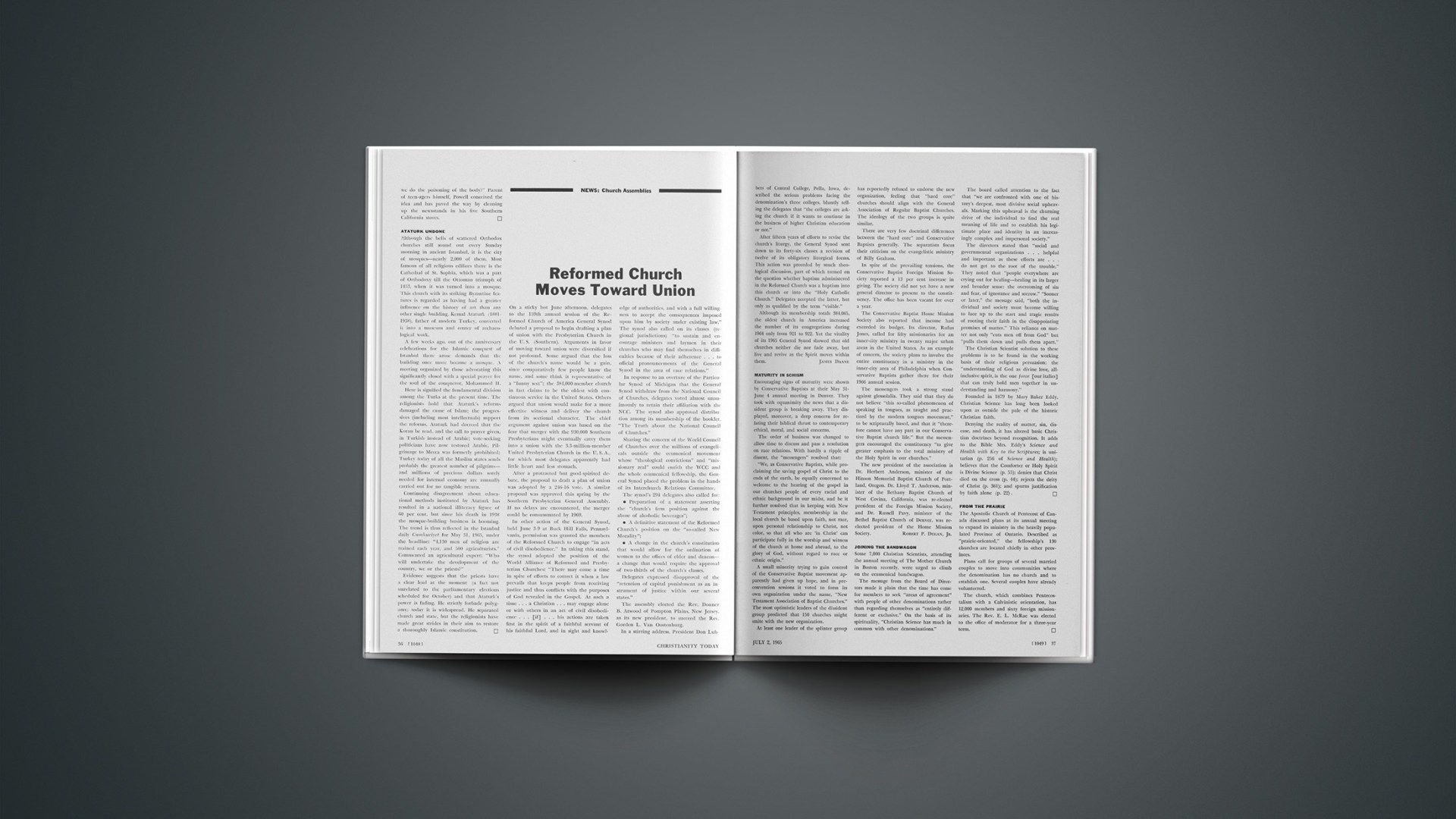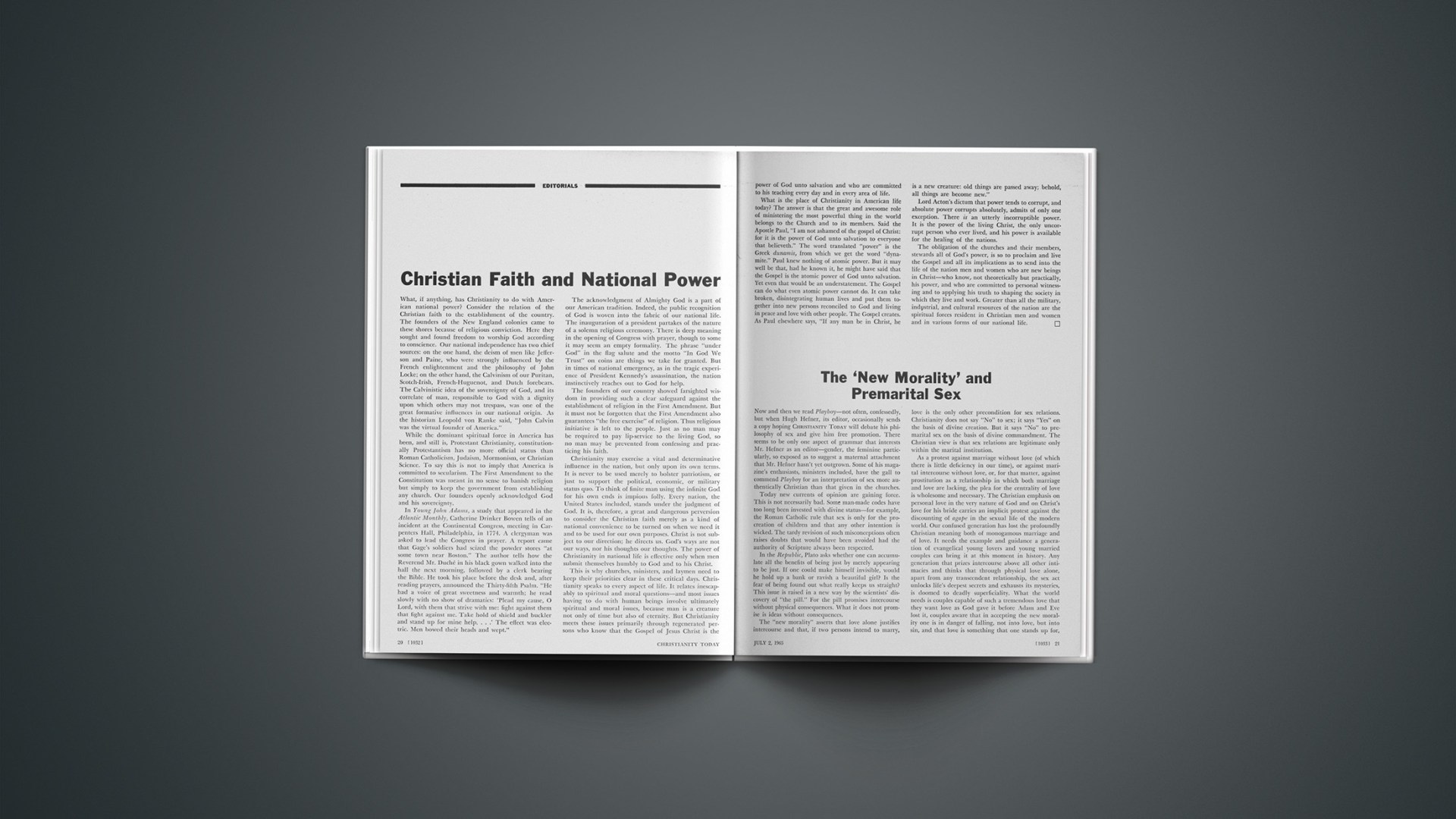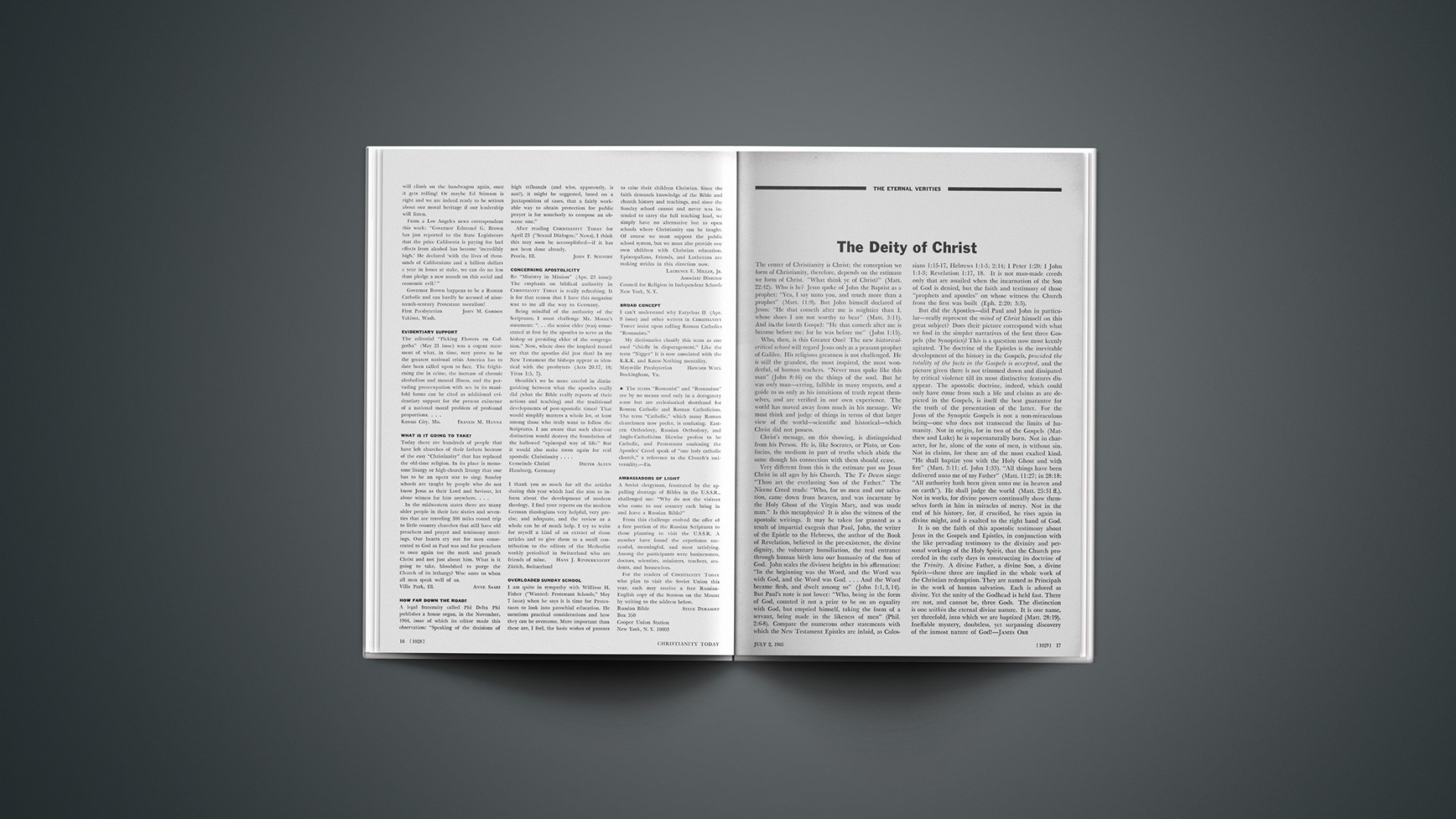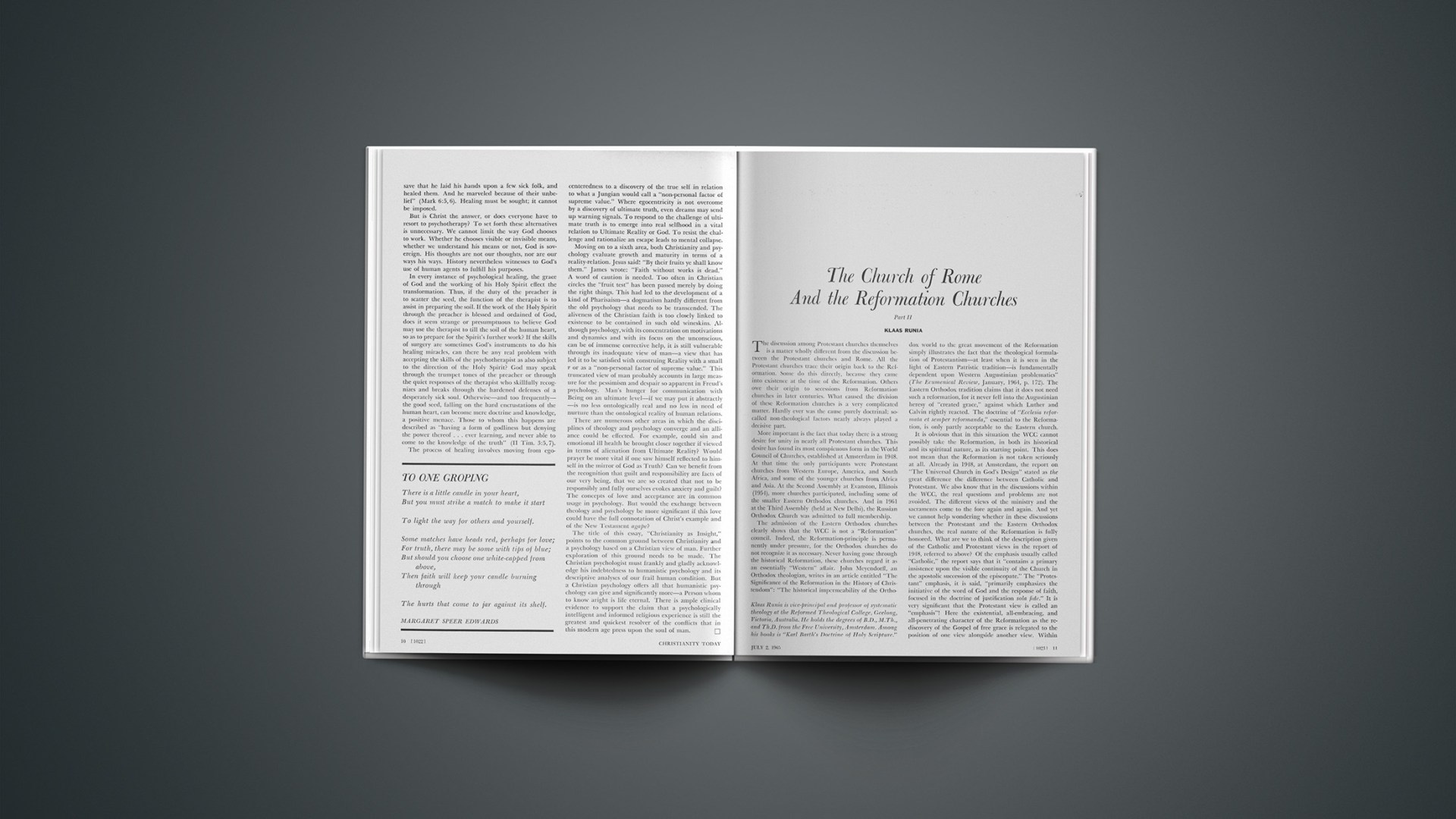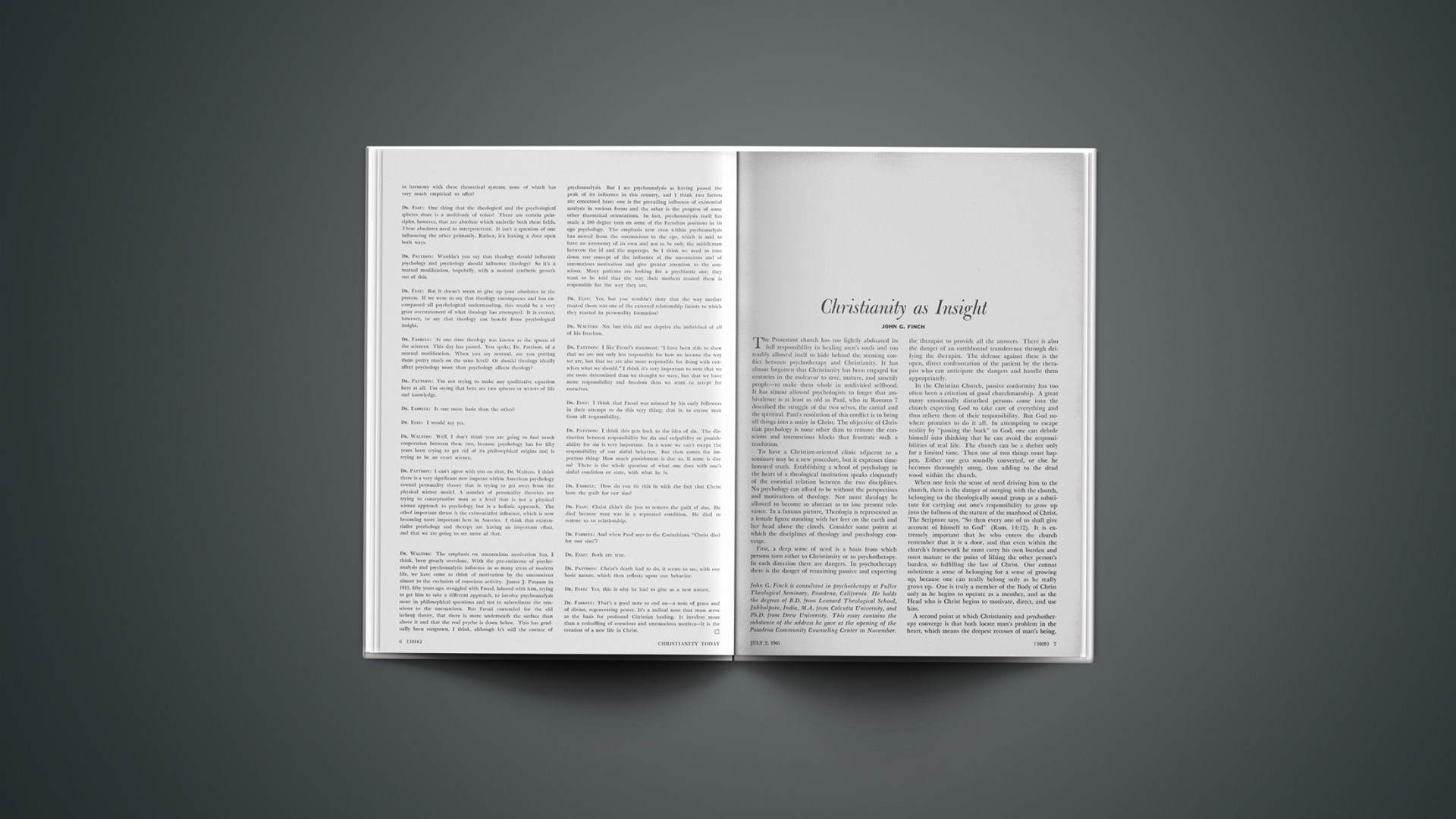NEWS: Church Assemblies
Reformed Church Moves Toward Union
On a sticky hot June afternoon, delegates to the 159th annual session of the Reformed Church of America General Synod debated a proposal to begin drafting a plan of union with the Presbyterian Church in the U. S. (Southern). Arguments in favor of moving toward union were diversified if not profound. Some argued that the loss of the church’s name would be a gain, since comparatively few people know the name, and some think it representative of a “funny sect”; the 384,000-member church in fact claims to be the oldest with continuous service in the United States. Others argued that union would make for a more effective witness and deliver the church from its sectional character. The chief argument against union was based on the fear that merger with the 930,000 Southern Presbyterians might eventually carry them into a union with the 3.3-million-member United Presbyterian Church in the U. S. A., for which most delegates apparently had little heart and less stomach.
After a protracted but good-spirited debate, the proposal to draft a plan of union was adopted by a 246–16 vote. A similar proposal was approved this spring by the Southern Presbyterian General Assembly. If no delays are encountered, the merger could be consummated by 1969.
In other action of the General Synod, held June 3–9 at Buck Hill Falls, Pennsylvania, permission was granted the members of the Reformed Church to engage “in acts of civil disobedience.” In taking this stand, the synod adopted the position of the World Alliance of Reformed and Presbyterian Churches: “There may come a time in spite of efforts to correct it when a law prevails that keeps people from receiving justice and thus conflicts with the purposes of God revealed in the Gospel. At such a time … a Christian … may engage alone or with others in an act of civil disobedience … [if] … his actions are taken first in the spirit of a faithful servant of his faithful Lord, and in sight and knowledge of authorities, and with a full willingness to accept the consequences imposed upon him by society under existing law.” The synod also called on its classes (regional jurisdictions) “to sustain and encourage ministers and laymen in their churches who may find themselves in difficulties because of their adherence … to official pronouncements of the General Synod in the area of race relations.”
In response to an overture of the Particular Synod of Michigan that the General Synod withdraw from the National Council of Churches, delegates voted almost unanimously to retain their affiliation with the NCC. The synod also approved distribution among its membership of the booklet, “The Truth about the National Council of Churches.”
Sharing the concern of the World Council of Churches over the millions of evangelicals outside the ecumenical movement whose “theological convictions” and “missionary zeal” could enrich the WCC and the whole ecumenical fellowship, the General Synod placed the problem in the hands of its Interchurch Relations Committee.
The synod’s 294 delegates also called for:
• Preparation of a statement asserting the “church’s firm position against the abuse of alcoholic beverages”;
• A definitive statement of the Reformed Church’s position on the “so-called New Morality”;
• A change in the church’s constitution that would allow for the ordination of women to the offices of elder and deacon—a change that would require the approval of two-thirds of the church’s classes.
Delegates expressed disapproval of the “retention of capital punishment as an instrument of justice within our several states.”
The assembly elected the Rev. Donner B. Atwood of Pompton Plains, New Jersey, as its new president, to succeed the Rev. Gorden L. Van Oostenburg.
In a stirring address, President Don Lubbers of Central College, Pella, Iowa, described the serious problems facing the denomination’s three colleges, bluntly telling the delegates that “the colleges are asking the church if it wants to continue in the business of higher Christian education or not.”
After fifteen years of efforts to revise the church’s liturgy, the General Synod sent down to its forty-six classes a revision of twelve of its obligatory liturgical forms. This action was preceded by much theological discussion, part of which turned on the question whether baptism administered in the Reformed Church was a baptism into this church or into the “Holy Catholic Church.” Delegates accepted the latter, but only as qualified by the term “visible.”
Although its membership totals 384,065, the oldest church in America increased the number of its congregations during 1964 only from 921 to 922. Yet the vitality of its 1965 General Synod showed that old churches neither die nor fade away, but live and revive as the Spirit moves within them.
Maturity In Schism
Encouraging signs of maturity were shown by Conservative Baptists at their May 31-June 4 annual meeting in Denver. They took with equanimity the news that a dissident group is breaking away. They displayed, moreover, a deep concern for relating their biblical thrust to contemporary ethical, moral, and social concerns.
The order of business was changed to allow time to discuss and pass a resolution on race relations. With hardly a ripple of dissent, the “messengers” resolved that:
“We, as Conservative Baptists, while proclaiming the saving gospel of Christ to the ends of the earth, be equally concerned to welcome to the hearing of the gospel in our churches people of every racial and ethnic background in our midst, and be it further resolved that in keeping with New Testament principles, membership in the local church be based upon faith, not race, upon personal relationship to Christ, not color, so that all who are ‘in Christ’ can participate fully in the worship and witness of the church at home and abroad, to the glory of God, without regard to race or ethnic origin.”
A small minority trying to gain control of the Conservative Baptist movement apparently had given up hope, and in preconvention sessions it voted to form its own organization under the name, “New Testament Association of Baptist Churches.” The most optimistic leaders of the dissident group predicted that 150 churches might unite with the new organization.
At least one leader of the splinter group has reportedly refused to endorse the new organization, feeling that “hard core” churches should align with the General Association of Regular Baptist Churches. The ideology of the two groups is quite similar.
There are very few doctrinal differences between the “hard core” and Conservative Baptists generally. The separatists focus their criticism on the evangelistic ministry of Billy Graham.
In spite of the prevailing tensions, the Conservative Baptist Foreign Mission Society reported a 13 per cent increase in giving. The society did not yet have a new general director to present to the constituency. The office has been vacant for over a year.
The Conservative Baptist Home Mission Society also reported that income had exceeded its budget. Its director, Rufus Jones, called for fifty missionaries for an inner-city ministry in twenty major urban areas in the United States. As an example of concern, the society plans to involve the entire constituency in a ministry in the inner-city area of Philadelphia when Conservative Baptists gather there for their 1966 annual session.
The messengers took a strong stand against glossolalia. They said that they do not believe “this so-called phenomenon of speaking in tongues, as taught and practiced by the modern tongues movement,” to be scripturally based, and that it “therefore cannot have any part in our Conservative Baptist church life.” But the messengers encouraged the constituency “to give greater emphasis to the total ministry of the Holy Spirit in our churches.”
The new president of the association is Dr. Herbert Anderson, minister of the Hinson Memorial Baptist Church of Portland, Oregon. Dr. Lloyd T. Anderson, minister of the Bethany Baptist Church of West Covina, California, was re-elected president of the Foreign Mission Society, and Dr. Russell Pavy, minister of the Bethel Baptist Church of Denver, was re-elected president of the Home Mission Society.
ROBERT P. DUGAN, JR.
Joining The Bandwagon
Some 7,000 Christian Scientists, attending the annual meeting of The Mother Church in Boston recently, were urged to climb on the ecumenical bandwagon.
The message from the Board of Directors made it plain that the time has come for members to seek “areas of agreement” with people of other denominations rather than regarding themselves as “entirely different or exclusive.” On the basis of its spirituality, “Christian Science has much in common with other denominations.”
The board called attention to the fact that “we are confronted with one of history’s deepest, most divisive social upheavals. Marking this upheaval is the churning drive of the individual to find the real meaning of life and to establish his legitimate place and identity in an increasingly complex and impersonal society.”
The directors stated that “social and governmental organizations … helpful and important as these efforts are … do not get to the root of the trouble.” They noted that “people everywhere are crying out for healing—healing in its larger and broader sense: the overcoming of sin and fear, of ignorance and sorrow.” “Sooner or later,” the message said, “both the individual and society must become willing to face up to the start and tragic results of rooting their faith in the disappointing promises of matter.” This reliance on matter not only “cuts men off from God” but “pulls them down and pulls them apart.”
The Christian Scientist solution to these problems is to be found in the working basis of their religious persuasion: the “understanding of God as divine love, all-inclusive spirit, is the one force [our italics] that can truly hold men together in understanding and harmony.”
Founded in 1879 by Mary Baker Eddy, Christian Science has long been looked upon as outside the pale of the historic Christian faith.
Denying the reality of matter, sin, disease, and death, it has altered basic Christian doctrines beyond recognition. It adds to the Bible Mrs. Eddy’s Science and Health with Key to the Scriptures; is Unitarian (p. 256 of Science and Health); believes that the Comforter or Holy Spirit is Divine Science (p. 55); denies that Christ died on the cross (p. 44); rejects the deity of Christ (p. 361); and spurns justification by faith alone (p. 22).
From The Prairie
The Apostolic Church of Pentecost of Canada discussed plans at its annual meeting to expand its ministry in the heavily populated Province of Ontario. Described as “prairie-oriented,” the fellowship’s 130 churches are located chiefly in other provinces.
Plans call for groups of several married couples to move into communities where the denomination has no church and to establish one. Several couples have already volunteered.
The church, which combines Pentecostalism with a Calvinistic orientation, has 12,000 members and sixty foreign missionaries. The Rev. E. L. McRae was elected to the office of moderator for a three-year term.

